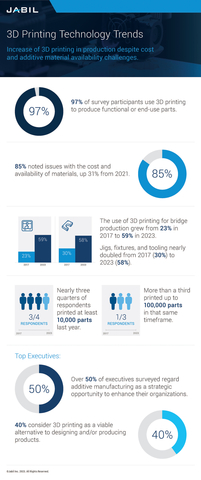Jabil Unveils Findings of Global Survey on 3D Printing Technology Trends
-
97% of survey participants use 3D printing to produce functional or end-use parts - Nearly three quarters of respondents printed at least 10,000 parts while more than a third printed up to 100,000 parts last year
-
85% of those polled grapple with the cost and availability of additive manufacturing materials that fit application requirements

Jabil's 2023 Global Survey on 3D Printing Technology Trends reveals increased trajectory of 3D printing technologies and differentiated additive materials for producing functional or end-use parts. (Graphic: Business Wire)
“The results of our latest manufacturing survey confirm our experiences in helping customers leverage the speed and agility of 3D printing to transform different manufacturing steps — from prototyping to production,” said Luke Rodgers, Jabil’s senior director of R&D for additive manufacturing. “In particular, this survey underscores how increased adoption of additive manufacturing is driving demand for differentiated additive materials with improved physical properties to deliver greater functionality, increased sustainability, and economies of scale.”
Jabil commissioned SIS International Research to conduct the 3D Printing Technology Trends Survey with participation from 200 additive manufacturing stakeholders worldwide. Questions were designed to offer a better understanding of decisions concerning 3D printing and additive manufacturing materials based on current opportunities, challenges, and industry developments. More than half of the top executives surveyed regard additive manufacturing as a strategic opportunity to enhance their organizations, while
A vast majority of the participants (
Other key findings include:
-
The top three use cases for 3D printing are prototyping (
97% ), research and development (75% ), and production parts (59% ). -
3D printing use for bridge production (moving from prototyping to initial production) grew from
23% in 2017 to59% in 2023, while 3D-printing jigs, fixtures, and tooling nearly doubled from 2017 (30% ) to 2023 (58% ). -
Prototyping is widely recognized for delivering the most significant impact to product lifecycles by
95% of the participants, followed by product designs (52% ) and small-scale production (27% ). - Additive manufacturing benefits have remained consistent since 2019, with the ability to deliver parts faster, decrease production costs, respond to issues on production lines, as well as enable production of personalized and customized goods.
Addressing Lingering Challenges in Additive Materials
Over the years, Jabil’s survey participants increasingly embraced the myriad advantages of additive manufacturing, yet issues concerning the cost and availability of materials have remained consistent. In fact, materials were identified as the primary financial or cost burden to adopting 3D printing by
Two-thirds of this year’s participants say they utilize custom-engineered materials as part of their overall additive manufacturing strategies. This finding may be in response to ongoing materials shortages, along with increased demands to produce parts with superior performance characteristics. Increased use of engineered materials with value-added attributes also reflects continued innovations in additive materials to improve the physical properties of end-use parts for greater utilization at lower costs, as well as faster delivery and less waste.
Overall, the use of plastics/polymers has been consistently pervasive among survey respondents since 2019. The use of metals, however, has greatly increased, from
Jabil Extends Additive Manufacturing from Ideation to Industrialization
Jabil continues to expand its global additive manufacturing solutions, encompassing continuous advancements in additive materials and leading-edge platforms to complement its global manufacturing capabilities. Among its additive materials innovations are Jabil PLA 3110P, a sustainable PLA powder based on NatureWorks’ Ingeo biopolymer; and Jabil PK 5000, an engineered material that delivers improved chemical resistance and resilience in comparison to general-purpose nylon materials.
About Jabil:
Jabil (NYSE: JBL) is a manufacturing solutions provider with over 250,000 employees across 100 locations in 30 countries. The world's leading brands rely on Jabil's unmatched breadth and depth of end-market experience, technical and design capabilities, manufacturing know-how, supply chain insights, and global product management expertise. Driven by a common purpose, Jabil and its people are committed to making a positive impact on their local community and the environment. Visit www.jabil.com to learn more.
View source version on businesswire.com: https://www.businesswire.com/news/home/20230727868823/en/
Michael Kovacs
Senior Director, Marketing, Jabil
1.408.427.1191
michael_kovacs@jabil.com
Source: Jabil, Inc.







